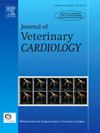晚期二尖瓣黏液瘤病犬左心房血栓形成
IF 1.3
2区 农林科学
Q2 VETERINARY SCIENCES
引用次数: 0
摘要
一只11岁的骑士查尔斯国王猎犬,先前诊断为临床前二尖瓣粘液瘤病(MMVD),表现为呼吸窘迫和腹胀。诊断为肺水肿和腹水。超声心动图显示MMVD的进展,因为它与左心室适度扩大和房间隔缺损(ASD)有关。后者被假设主要是由于MMVD引起的房间隔破裂。此外,左心房内有高回声不规则肿块。当时,主要的鉴别诊断包括心内血栓形成(ICT)和壁性心内膜炎。综合诊断测试随后排除了心外血栓形成的触发因素;此外,血液和尿液培养均呈阴性。尽管给予心脏和支持性治疗(包括抗血栓药物),狗在出现后138天死亡。尸检证实存在MMVD(根据Pomerance和Whitney的分类系统为IV型病变),并伴有左侧心腔重构、多发左心房(LA)喷流病变和ASD。心内膜炎被排除,LA肿块被证明是被困在ASD中的ICT。根据死前和死后的发现,二尖瓣功能不全和ASD继发的湍流血流,以及广泛的LA内皮损伤,被认为是ICT发展的可能触发因素。本病例表明,尽管ICT是犬类心脏病的一种极其罕见的并发症,但当犬类MMVD特别严重时,它可能会发生。本文章由计算机程序翻译,如有差异,请以英文原文为准。
Left atrial thrombosis in a dog with advanced myxomatous mitral valve disease
An 11-year-old Cavalier King Charles spaniel with a previous diagnosis of preclinical myxomatous mitral valve disease (MMVD) was presented with respiratory distress and abdominal distension. Lung edema and ascites were diagnosed. Echocardiography revealed a progression of the MMVD as it was associated with a moderate enlargement of the left-sided cardiac chambers and an atrial septal defect (ASD). The latter was hypothesized to be primarily due to a rupture of the interatrial septum caused by MMVD. Moreover, a hyperechoic irregular mass was documented inside the left atrium. At that time, the primary differential diagnosis included intracardiac thrombosis (ICT) and mural endocarditis. Comprehensive diagnostic tests subsequently ruled out extracardiac prothrombotic triggers; moreover, both blood and urine cultures tested negative. Despite the administration of cardiac and supportive therapies (including antithrombotic drugs), the dog died 138 days after presentation. Necropsy confirmed the presence of MMVD (type IV lesions according to Pomerance and Whitney's classification system) associated with remodeling of the left-sided cardiac chambers, multiple left atrial (LA) jet lesions, and ASD. Endocarditis was ruled out, and the LA mass was demonstrated to be an ICT entrapped in the ASD. In light of premortem and postmortem findings, the turbulent blood flow secondary to the mitral valve insufficiency and ASD, along with the extensive LA endothelial damage, were considered likely triggering factors for the development of ICT. This case suggests that, although ICT represents an extremely rare complication of cardiac diseases in dogs, it can potentially develop when canine MMVD is particularly advanced.
求助全文
通过发布文献求助,成功后即可免费获取论文全文。
去求助
来源期刊

Journal of Veterinary Cardiology
VETERINARY SCIENCES-
CiteScore
2.50
自引率
25.00%
发文量
66
审稿时长
154 days
期刊介绍:
The mission of the Journal of Veterinary Cardiology is to publish peer-reviewed reports of the highest quality that promote greater understanding of cardiovascular disease, and enhance the health and well being of animals and humans. The Journal of Veterinary Cardiology publishes original contributions involving research and clinical practice that include prospective and retrospective studies, clinical trials, epidemiology, observational studies, and advances in applied and basic research.
The Journal invites submission of original manuscripts. Specific content areas of interest include heart failure, arrhythmias, congenital heart disease, cardiovascular medicine, surgery, hypertension, health outcomes research, diagnostic imaging, interventional techniques, genetics, molecular cardiology, and cardiovascular pathology, pharmacology, and toxicology.
 求助内容:
求助内容: 应助结果提醒方式:
应助结果提醒方式:


